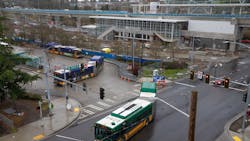King County Metro announces proposals for bus and light rail integration in north King County driven by community guidance
King County Metro and Sound Transit are finalizing an integrated, customer-centered transit network with more than 30 bus routes to connect with Link light rail, while focusing om improving access to opportunities for historically underserved residents.
King County Metro launched a survey and community engagement effort seeking public feedback on a proposed new bus network, creating stronger connections to Sound Transit’s three future Link light-rail stations opening in Seattle in 2021. The online survey is in English, Spanish, Chinese, Vietnamese, Korean and Arabic. King County Metro will be at community events and meetings scheduled by community groups that are open to the public.
“As our region grows, improving and expanding public transit enhances our quality of life, extends opportunity and protects our environment,” said King County Executive Dow Constantine, who also vice chair of the Sound Transit Board of Directors. “We've been working with a community-based Mobility Board to hear how we can best serve residents, and the proposed updates to King County Metro’s bus network will do just that by connecting buses with fast, reliable light rail.” Based on Mobility Board members’ consideration of broader public feedback and input, the proposed bus network would:
- Improve east-west crosstown connections;
- Create transfer points that are convenient and easy for customers to understand;
- Make transit travel times for many trips faster and more consistent by connecting with light rail;
- Increase access to hospitals and medical facilities (Northgate, UW, First Hill, Seattle Children’s); and
- Expand opportunity through connections to growing job centers like South Lake Union.
“To quote Stevie Wonder ‘We need to make every single thing accessible to every single person with hurdles.’ This is why I am part of the Mobility Board and worked on creating this network with Metro to ensure that this point of view is represented throughout the process and provides accessibility for all,” said Christina Sargent, Mobility Board member.
The next phase for Link light-rail expansion
For decades, bus service on established transit corridors has connected customers to Northgate, the Roosevelt area and the University District, and in 2021 that will shift and evolve with the addition of new light-rail stations in each of these three neighborhoods. King County Metro has upgraded and revised the transit network with each new phase of Sound Transit’s expansion to connect people to Link and better connect them within their communities.
Sound Transit is extending light rail from the University of Washington at Husky Stadium to Northgate Transit Center, opening two underground stations in the University District and Roosevelt and an elevated station at Northgate in 2021.
Because light rail avoids traffic congestion, riders reach their destinations faster and more reliably. This opens new opportunities to make transit work better for existing and new customers.
This phase of the Link light-rail expansion will be King County Metro’s largest service restructure since Sound Transit extended light rail to the University of Washington in 2016. That extension resulted in combined transit ridership in the ULink service area of Northeast Seattle and Capitol Hill climbing 14 percent from 2015 and 2018 as new customers chose to ride buses and light rail.
Changes are being considered to more than 30 King County Metro routes and to Sound Transit Express Route 522. These buses serve communities within Bothell, Kenmore, Lake Forest Park, Seattle and Shoreline. The service updates will bring more people to and from light-rail stations and respond to changing transportation needs.
Each year, King County Metro serves an estimated 30 million weekday rides in the service area under evaluation, accounting for 740,000 annual service hours – about 18 percent of King County Metro’s service. Key among the services in the area is Route 41 between downtown Seattle and Northgate, King County Metro’s ninth busiest route providing an estimated 8,800 rides daily.
Major opportunity for improving mobility and connections
As part of the first planning stage of the mobility project, King County Metro says it engaged with the neighborhoods most impacted by the upcoming service changes and focused specifically on communities who are disproportionately affected by transit inequities, including people of color, low-income residents, limited or non-English speaking communities, riders with disabilities, immigrants and refugees.
King County Metro says it worked directly with these communities to develop a transit network that illustrates the range of opportunities to minimize duplication of King County Metro service with Link light rail, improve connections to light rail, redesign existing fixed-route service, provide new east-west connections, improve service to job centers like South Lake Union and First Hill and respond to current and future mobility needs.
This project is underway in coordination with Sound Transit, the Seattle Department of Transportation, Community Transit and many other partners.
Sound Transit and Community Transit are discussing how bus service to and from Snohomish County can seamlessly integrate with light rail at the new light-rail stations. Both agencies are talking to riders about adjusting ST Express and Community Transit service to create a more reliable regional transit network between 2021 and 2024, when the Lynnwood Link Extension is scheduled to open.
